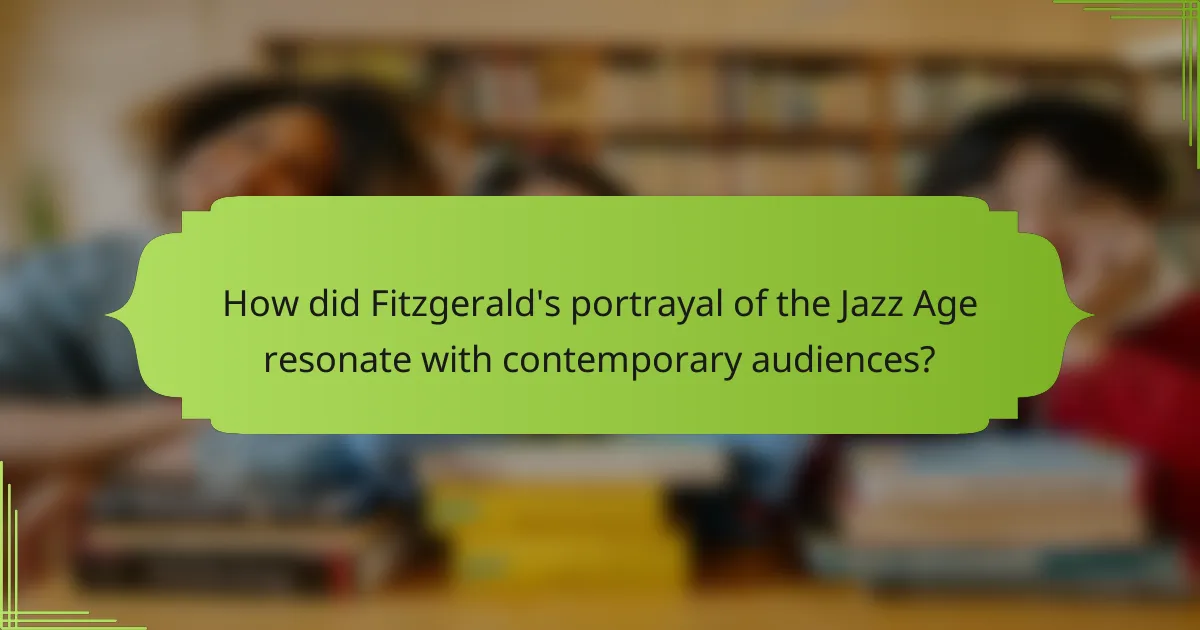F. Scott Fitzgerald’s exploration of the Jazz Age reveals profound insights into wealth, love, and societal expectations. His personal struggles shaped the emotional depth of his characters. The use of symbolism, particularly the green light, illustrates unattainable dreams. Fitzgerald’s narrative techniques, including stream of consciousness and unreliable narration, enhance the complexity of his themes.

How did F. Scott Fitzgerald’s life influence his literary themes?
F. Scott Fitzgerald’s life significantly influenced his literary themes, particularly through his experiences during the Jazz Age. His reflections on wealth, love, and societal expectations are evident in his narratives.
Fitzgerald’s personal struggles, including his tumultuous marriage and battles with alcoholism, shaped the emotional depth of his characters. For example, the disillusionment depicted in “The Great Gatsby” mirrors his own discontent with the American Dream.
Additionally, Fitzgerald’s use of symbolism, such as the green light representing unattainable goals, reflects his unique perspective on aspiration and failure. The Jazz Age’s cultural dynamism infused his work with vibrant imagery and complex social commentary.
In summary, Fitzgerald’s life experiences and the historical context of his time are intricately woven into the themes of his literary works, creating a rich tapestry of narrative techniques and symbolism.
What personal experiences shaped his perspective on the Jazz Age?
F. Scott Fitzgerald’s personal experiences with wealth, love, and loss profoundly shaped his perspective on the Jazz Age. His tumultuous relationship with Zelda Sayre, marked by both passion and instability, influenced his portrayal of extravagant lifestyles and the pursuit of happiness. Witnessing the excesses of the 1920s, Fitzgerald reflected societal disillusionment, particularly through characters like Jay Gatsby. The contrast between idealism and reality in his works highlights the era’s fleeting nature and moral ambiguity.
How did his relationships impact his writing style?
F. Scott Fitzgerald’s relationships significantly shaped his writing style, infusing it with emotional depth and social critique. His tumultuous marriage to Zelda Sayre provided rich material for exploring themes of love, ambition, and disillusionment. The Jazz Age backdrop influenced his narrative techniques, reflecting societal changes and personal struggles. As a result, Fitzgerald’s prose became a blend of lyrical beauty and stark realism, capturing the complexities of human connections.
Which historical events are reflected in his works?
F. Scott Fitzgerald’s works reflect significant historical events such as the Roaring Twenties, the Great Depression, and the disillusionment following World War I. His narratives capture the essence of the Jazz Age, showcasing themes of wealth, excess, and moral decay. For example, “The Great Gatsby” symbolizes the American Dream’s corruption, illustrating social stratification and the pursuit of unattainable ideals. Fitzgerald’s use of symbolism, like the green light, represents hope and the elusive nature of dreams, mirroring the societal changes of his time.

What are the key themes in Fitzgerald’s novels?
F. Scott Fitzgerald’s novels explore themes of disillusionment, the American Dream, and social class dynamics. His works often reflect the excesses and moral decay of the Jazz Age through rich symbolism and complex narrative techniques. Disillusionment is evident in “The Great Gatsby,” where characters grapple with unattainable dreams. The American Dream theme highlights the pursuit of wealth and status, often leading to tragic outcomes. Fitzgerald’s use of symbolism, such as the green light in “Gatsby,” encapsulates longing and hope. His narrative techniques, including unreliable narrators and vivid imagery, deepen the emotional resonance of his themes.
How does the concept of the American Dream manifest in his works?
F. Scott Fitzgerald’s works vividly illustrate the American Dream through themes of aspiration and disillusionment. His characters often pursue wealth and status, reflecting the era’s values. In “The Great Gatsby,” Gatsby’s relentless quest for success symbolizes the elusive nature of the American Dream. Fitzgerald employs symbolism, such as the green light, to represent hope and unattainable goals. His narrative techniques, including vivid imagery and complex characterizations, deepen the exploration of this theme, revealing the stark contrast between dreams and reality.
What role does wealth and social status play in his narratives?
Wealth and social status are central themes in F. Scott Fitzgerald’s narratives, reflecting the moral decay of the Jazz Age. His characters often navigate a world where affluence dictates relationships and self-worth. For instance, Jay Gatsby’s lavish parties symbolize the pursuit of status, yet reveal the emptiness behind wealth. Fitzgerald critiques this superficiality, illustrating how social hierarchies impact personal connections and aspirations. Ultimately, wealth serves as both a catalyst for ambition and a barrier to genuine fulfillment in his storytelling.
How is the theme of love portrayed in his stories?
F. Scott Fitzgerald portrays love as complex and often unattainable in his stories. His characters experience love intertwined with themes of wealth, ambition, and societal expectations. For example, in “The Great Gatsby,” Gatsby’s idealized love for Daisy symbolizes the elusive American Dream. This unique portrayal highlights love’s fragility amid the Jazz Age’s excesses. Fitzgerald’s narrative techniques, such as symbolism and unreliable narration, deepen the exploration of love’s multifaceted nature, revealing both its beauty and its potential for heartbreak.

Which narrative techniques are prevalent in Fitzgerald’s writing?
F. Scott Fitzgerald’s writing employs prevalent narrative techniques such as stream of consciousness, unreliable narration, and symbolism. These techniques enhance the exploration of themes like disillusionment and the American Dream. Fitzgerald’s use of vivid imagery and rich character development further immerses readers in the Jazz Age. His unique approach to narrative structure often reflects the fragmented nature of modern life, making his work resonate with contemporary audiences.
How does he use symbolism to enhance storytelling?
F. Scott Fitzgerald uses symbolism to deepen themes and character development in his storytelling. Through symbols like the green light in “The Great Gatsby,” he conveys the elusive nature of the American Dream. This unique attribute enhances emotional resonance, allowing readers to explore complex societal issues. Symbols serve as a narrative device, enriching the text and inviting multiple interpretations. Fitzgerald’s use of symbolism ultimately transforms simple narratives into profound reflections on human experience.
What are the characteristics of his narrative voice?
F. Scott Fitzgerald’s narrative voice is characterized by lyrical prose, rich symbolism, and a reflective tone. His use of first-person perspective creates intimacy, while his intricate descriptions evoke the Jazz Age’s complexities. Fitzgerald’s unique attribute lies in his ability to blend personal experience with broader societal critiques, often revealing the disillusionment beneath the era’s glamour. This narrative style invites readers to explore deeper themes of aspiration and loss.
How does Fitzgerald employ unreliable narrators?
Fitzgerald employs unreliable narrators to create ambiguity and enhance thematic depth. In “The Great Gatsby,” Nick Carraway’s subjective perspective shapes the narrative, revealing his biases and limitations. This technique invites readers to question the truth behind events and characters, reflecting the disillusionment of the Jazz Age. Fitzgerald’s use of unreliable narration emphasizes the contrast between appearance and reality, a key theme in his work. By presenting a flawed viewpoint, he deepens the complexity of the characters and their motivations, encouraging critical engagement with the text.

What symbols are most significant in Fitzgerald’s works?
F. Scott Fitzgerald’s works are rich with significant symbols, including the green light, the valley of ashes, and the eyes of Dr. T.J. Eckleburg. The green light represents Gatsby’s unattainable dreams and the American Dream itself. The valley of ashes symbolizes moral decay resulting from the uninhibited pursuit of wealth. The eyes of Dr. T.J. Eckleburg serve as a haunting reminder of the loss of spiritual values in a materialistic society. These symbols deepen the narrative and reflect the complexities of the Jazz Age.
How does the green light symbolize hope and ambition?
The green light symbolizes hope and ambition through its representation of unattainable dreams. In F. Scott Fitzgerald’s narrative, the light serves as a beacon for Gatsby’s aspirations, embodying his relentless pursuit of success and love. This symbolism reflects the broader themes of the Jazz Age, where the pursuit of the American Dream often led to disillusionment. The light’s position across the bay emphasizes the distance between reality and aspiration, highlighting the tension between desire and the harsh truths of life.
What does the valley of ashes represent in “The Great Gatsby”?
The valley of ashes symbolizes the moral and social decay resulting from the uninhibited pursuit of wealth in “The Great Gatsby.” It represents the stark contrast between the opulence of East Egg and the desolation of the working class. This setting illustrates the consequences of the American Dream’s corruption, highlighting themes of disillusionment and the loss of hope. The imagery of ashes evokes a sense of despair and emptiness, reflecting the characters’ struggles and the broader societal issues of the Jazz Age.
How are colors used to convey deeper meanings?
Colors in F. Scott Fitzgerald’s works symbolize deeper themes and emotions, enhancing narrative depth. For instance, the green light in “The Great Gatsby” represents Gatsby’s unattainable dreams. Additionally, the use of gold signifies wealth and decadence, contrasting with the moral decay of the Jazz Age. Colors evoke feelings and establish a mood, allowing readers to connect with the characters’ inner struggles and societal critiques. Fitzgerald’s deliberate color choices create a rich tapestry of meaning, reflecting the complexities of his era.

How did Fitzgerald’s portrayal of the Jazz Age resonate with contemporary audiences?
Fitzgerald’s portrayal of the Jazz Age resonated deeply with contemporary audiences due to its exploration of excess, disillusionment, and the American Dream. His characters, often emblematic of the era’s moral ambiguity, mirrored societal shifts and aspirations. The vivid symbolism in works like “The Great Gatsby” highlighted the contrast between wealth and emptiness, capturing the zeitgeist of the 1920s. Additionally, Fitzgerald’s narrative techniques, including stream-of-consciousness and rich imagery, engaged readers by immersing them in the era’s complexities, making his reflections timeless and relevant.
What cultural shifts did his works reflect during the 1920s?
F. Scott Fitzgerald’s works reflected significant cultural shifts during the 1920s, emphasizing themes of disillusionment and excess. His narratives captured the spirit of the Jazz Age, highlighting the clash between traditional values and modernity. The characters often embodied the pursuit of wealth and social status, revealing the era’s moral complexities. Symbolism in his writing, such as the green light in “The Great Gatsby,” illustrated the unattainable American Dream. Fitzgerald’s unique narrative techniques, including stream of consciousness, deepened the emotional resonance of these cultural critiques.
How has the perception of the Jazz Age evolved over time?
The perception of the Jazz Age has transformed from a celebration of excess to a more critical view of its societal impacts. Initially, the Jazz Age symbolized liberation and modernity, characterized by vibrant cultural shifts and economic prosperity. Over time, scholars and critics have highlighted the era’s underlying issues, such as moral decay and disillusionment. F. Scott Fitzgerald’s works, particularly “The Great Gatsby,” encapsulate this duality, portraying both the allure and the emptiness of the American Dream. Today, the Jazz Age is often revisited as a cautionary tale about the consequences of unbridled ambition and social stratification.
Which elements of Fitzgerald’s writing continue to influence modern literature?
F. Scott Fitzgerald’s exploration of the Jazz Age, use of symbolism, and innovative narrative techniques profoundly influence modern literature. His depiction of the American Dream, particularly its disillusionment, resonates in contemporary works. Fitzgerald’s rich symbolism, such as the green light in “The Great Gatsby,” continues to inspire authors seeking to convey complex themes. Additionally, his narrative style, blending lyrical prose with sharp social commentary, sets a precedent for modern storytelling.

What challenges did Fitzgerald face as a writer?
F. Scott Fitzgerald faced numerous challenges as a writer, including financial instability and personal struggles. His works often reflected the disillusionment of the Jazz Age, yet he struggled to gain critical acclaim during his lifetime. The complexity of his narrative techniques also posed difficulties in achieving mainstream success. Additionally, Fitzgerald battled alcoholism, which affected his productivity and relationships. These factors contributed to the inconsistency in his literary career and the posthumous recognition of his genius.
How did financial struggles impact his creative output?
Financial struggles significantly hindered F. Scott Fitzgerald’s creative output, impacting his productivity and thematic focus. Economic hardship led to increased anxiety and disillusionment, which influenced his narrative techniques. The Great Depression exacerbated his financial difficulties, resulting in a decline in both his writing quality and quantity. As a result, his later works, such as “Tender Is the Night,” reflect a more somber tone compared to the exuberance of his earlier pieces.
What role did alcoholism play in his life and writing?
Alcoholism significantly influenced F. Scott Fitzgerald’s life and writing, often serving as both a muse and a destructive force. His struggles with alcohol shaped his personal relationships and provided a backdrop for the themes of excess and disillusionment in his works. The character Jay Gatsby, for instance, reflects the era’s hedonism and the personal toll of addiction. Fitzgerald’s experiences with alcohol also led to his decline, mirroring the decline of the American Dream he critiqued in his narratives. Ultimately, his alcoholism became a unique attribute of his life story, intertwining with his literary legacy.
How did critical reception of his work change over his lifetime?
Critical reception of F. Scott Fitzgerald’s work evolved significantly throughout his lifetime. Initially, he gained acclaim for “The Great Gatsby,” but later faced criticism and neglect. His innovative narrative techniques and symbolism were often underappreciated during his later years. Posthumously, Fitzgerald’s work received renewed recognition, establishing him as a literary icon of the Jazz Age.

What lessons can modern writers learn from Fitzgerald’s approach?
Modern writers can learn the importance of rich symbolism and narrative techniques from Fitzgerald’s approach. His use of vivid imagery and metaphor enhances storytelling, creating deeper emotional connections. Writers should focus on character depth, reflecting societal values and complexities. Incorporating historical context can also enrich narratives, making them more relatable and impactful. Lastly, exploring themes of aspiration and disillusionment can resonate with contemporary audiences, mirroring today’s societal challenges.
How can symbolism be effectively integrated into storytelling?
Symbolism can enhance storytelling by adding depth and layers of meaning. F. Scott Fitzgerald effectively uses symbolism to reflect the complexities of the Jazz Age. For example, the green light in “The Great Gatsby” symbolizes Gatsby’s unattainable dreams and the broader American Dream. This unique attribute of symbolism allows readers to engage with the narrative on a deeper emotional level. Additionally, Fitzgerald’s use of color symbolism, such as the contrast between the Valley of ashes and the opulence of East Egg, highlights social disparities and moral decay. Integrating such symbols creates a rich narrative tapestry that resonates with readers.
What best practices can be drawn from his narrative techniques?
F. Scott Fitzgerald’s narrative techniques emphasize depth, symbolism, and character complexity. Key best practices include using rich symbolism to convey themes, employing unreliable narrators to enhance perspective, and creating vivid settings that reflect characters’ emotions. These techniques foster a deeper connection between the reader and the narrative, making the story more engaging and thought-provoking. Fitzgerald’s unique use of language and structure also contributes to the overall impact, encouraging writers to experiment with style and form.
How can writers navigate personal experiences in their works?
Writers can navigate personal experiences by using them as a foundation for their narratives. F. Scott Fitzgerald effectively incorporated his own life into his works, particularly in “The Great Gatsby.” His reflections on the Jazz Age reveal social dynamics and personal struggles. Symbolism, such as the green light and the valley of ashes, enhances the emotional depth of his storytelling. Fitzgerald’s narrative techniques, including unreliable narrators and intricate character development, allow readers to engage with his personal experiences on multiple levels.